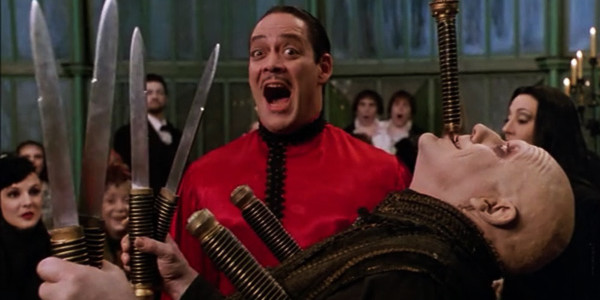The American ideal of the family is inherently conformist, consisting of a heteronormative married couple with 2.5 children and a modest income. Not only is this “family” expected to operate within each of their roles, but a large dollop of cynicism disguised as relatable observation allows for dysfunction to exist, presenting it as a natural side effect of family life. While this ideal is more easily accepted in times of economic prosperousness, it fails miserably during times of depression, be it economical, cultural or political. It’s no mistake, then, that artist Charles Addams’ cartoons depicting the decidedly non-conformist Gomez, Morticia, Wednesday, Pugsley, and Uncle Fester began appearing soon after the Great Depression in the late ‘30s. Addams’ characters were openly macabre, playing on tropes of Gothic horror and Grand Guignol humor, but the satiric meat of the cartoons lay in the Addams’ rejection of so-called traditional values. This satire-by-contrast continued when the famous TV series “The Addams Family” began in the mid-‘60s (itself a decade of strife), and remained blissfully intact in the major motion picture adaptation made and released in the midst of the George H.W. Bush presidency, 1991’s THE ADDAMS FAMILY.
THE ADDAMS FAMILY was one of the first movies to be spun off from Golden Age TV programs, yet unlike contemporary efforts such as DRAGNET (1987) and THE BRADY BUNCH MOVIE (1995)—both of which found humor in contrasting their stuck-in-a-past-era characters with the more progressive late 20th century—the Addamses had contrast and satire baked directly into their premise already, eschewing the need for any postmodern commentary. The road for the Addamses had already been paved by 1991 thanks in large part to Tim Burton, whose films about macabre misfits living in a Gothic horror landscape (1988’s BEETLEJUICE, 1990’s EDWARD SCISSORHANDS, and even 1989’s BATMAN) had been huge box office hits. Burton was the natural and expected choice to helm THE ADDAMS FAMILY, and while the filmmaker ended up not being involved, the credited screenwriters Caroline Thompson and Larry Wilson were both Burton alums (having worked on SCISSORHANDS and BEETLEJUICE, respectively), giving the finished film a distinctly Burton-esque aftertaste. The producers’ next choice was Barry Sonnenfeld, a first-time director who’d already had a prestigious career working as a regular cinematographer for both Rob Reiner and the Coen brothers. Sonnenfeld, like Burton, could do comedy with a skewed perspective: he’d shot dark comedies RAISING ARIZONA and THROW MOMMA FROM THE TRAIN (both 1987) as well as the Stephen King pas de deux MISERY (1990), which had its black comedic moments.

Sonnenfeld’s hiring and his impeccable choice of cast turned THE ADDAMS FAMILY into the perfect fusion of cartoon and live action, honoring the characters’ various prior incarnations. Sonnenfeld’s camera (the film was fraught with production issues and delays, leaving the director to finish shooting the movie himself) careens from shot to shot with abundant energy, the Gothic production design of Richard Macdonald milked for all its worth while editors Dede Allen and Jim Miller barely keep up. The film’s exuberance is best represented by the manic Christopher Lloyd as “Gordon”/Uncle Fester and Raul Julia as Gomez. The latter is matched perfectly by the slinky Femme Fatale-meets-Vampira performance of Anjelica Huston as Morticia, and the family ensemble is completed by the blank slate Pugsley (Jimmy Workman) and the deliciously deadpan Wednesday (Christina Ricci). In presenting the Addamses as “kooky” individuals that culture clash with the “normal” people surrounding them, the film reaches a level of theatricality that never veers over the edge into camp but instead gets the maximum amount of satire out of the comparisons. It’s no surprise that playwright Paul Rudnick—who would become the sole credited screenwriter for the film’s even more satiric sequel, 1993’s ADDAMS FAMILY VALUES—did a final uncredited rewrite of the script, giving the movie a sharper comedic bite than most Hollywood comedies have, especially those exploiting IP.

The secret to THE ADDAMS FAMILY’s success (beyond the eccentric cinematography, production design, and iconic performances) lies in its appealing to the audience’s kooky side, turning the Addamses into counterculture, anti-establishment heroes of a sort. The plot concerns a brainwashed Uncle Fester acting as a sleeper agent inside the family on behalf of his “mother,” the con artist Abigail (Elisabeth Wilson) and the Addams’ shady lawyer, Tully (Dan Hedaya), who’ve concocted a plot to steal the Addams’ fortune. When the thieves are (briefly) successful, the Addamses are forced further into “normal” middle class society, the film finding new ways to comment on the bizarre social norms that make up the establishment, many of which were and are far stranger and more troubling than the Addams’ love of all things spooky. This is evident in scenes ranging from Morticia wearily observing how Wednesday’s fellow public school students have made heroic art tributes to President Bush to a destitute Gomez repeatedly calling talk show host Sally Jesse Raphael in order to find out more about these witches and devil worshippers her show keeps parading in front of the camera. There’s something undeniably cool about the Addamses—they even have their own theme song performed by MC Hammer, who was at the height of his popularity in 1991. It’s why the crux of the plot, Fester learning to love the family and then wishing to be part of them above all else, is so compelling—in essence, we want what Fester wants, to be accepted by these lovable creeps so that we’ll be seen for the individuals we are. THE ADDAMS FAMILY, the characters as well as the film, is a love letter to horror nerds, goths, punks, rejects, and rebels of any kind. It explodes the traditional notions of the American family, presenting people who deeply and openly love each other while expressing every macabre thought that pops into their heads. In the realm of TV show-to-movie adaptations and big budget comedies in general, THE ADDAMS FAMILY remains unique, impressive and delightfully kooky.
Tags: Addams, Anjelica Huston, Anniversaries, Barry Sonnenfeld, Carel Struycken, Caroline Thompson, Charles Addams, Christina Ricci, Christopher Lloyd, Dan Hedaya, Dede Allen, Elisabeth Wilson, Fester, Gomez, Gothic, Gothic Horror, Jim Miller, Jimmy Workman, Larry Wilson, MC Hammer, Morticia, Paul Rudnick, Pugsley, Raul Julia, Richard Macdonald, satire, The Addams Family, Wednesday



No Comments